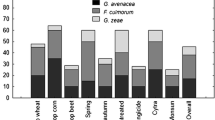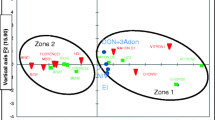Summary
Deoxynivalenol (DON), moniliformin (MON) and zearalenone (ZON) are the most important mycotoxins detected in Fusarium infected wheat grains in Austria. Our goal was to identify an evaluation method for Fusarium head blight (FHB) symptoms, which is closely related to the toxin content in grains of artificially inoculated wheat genotypes. In total 108 wheat lines with varying FHB resistance were treated with F. culmorum (DON producer), F. avenaceum (MON producer) or F. graminearum (ZON producer). Several FHB evaluation methods were investigated and the data were correlated with the mycotoxin content of the grains. Data on the visual scores of the FHB development in the field, percentage of Fusarium damaged kernels and specific grain weight showed acceptable correlations with the DON content (r=0.75-0.81). MON contamination was closely related to the percentage of Fusarium damaged kernels (r=0.70). No suitable method was identified to predict ZON concentrations. Only in grain samples of highly resistant genotypes consistently a low ZON content was measured.
Similar content being viewed by others
References
Arseniuk, E., E. Foremska, T. Góral, and J. Chelkowsky, 1999. Fusarium head blight reactions and accumulation of deoxynivalenol (DON) and some of its derivatives in kernels of wheat, triticale and rye. J. Phytopathology 147, 577–590.
Atanassov, Z., C. Nakamura, N. Mori, C. Kaneda, H. Kato, Y.-Z. Jin, T. Yoshizawa, and K. Murai, 1994. Mycotoxin production and pathogenicity of Fusarium species and wheat resistance to Fusarium head blight. Can. J. Botany 72, 161–167.
Buerstmayr, H., M. Lemmens, H. Grausgruber, and P. Ruckenbauer, 1996. Scab resistance of international wheat germplasm. Cereal Res. Comm. 24, 195–202.
Golinski, P., I. Kiecana, Z. Kaczmarek, M. Kostecki, P. Kaptur, H. Wisniewska, and J. Chelkowsky, 1999. Scab response of selected winter wheat cultivars after inoculation with Fusarium avenaceum (Fr.) Sacc. J. Phytopathol. 147, 717–723.
Jones, R. K., and C. J. Mirocha, 1999. Quality parameters in small grains from Minnesota affected by Fusarium head blight. Plant Dis. 83, 506–511.
Krska, R., S. Baumgartner, and R. Josephs, 2001. The state-of-the-art in the analysis of type-A and -B trichothecene mycotoxins in cereals. Fresenius J. Anal. Chem. 371, 285–299.
Lemmens, M., H. Buerstmayr, and P. Ruckenbauer, 1993. Variation in Fusarium head blight susceptibility of international and Austrian wheat breeding material. Die Bodenkultur 44, 65–78.
Lew, H., 1993. Die aktuelle Mykotoxinsituation in der heimischen Landwirtschaft. In: Veröff. Bundesanstalt für Agrarbiologie Linz/Donau 21, 5–26.
Liu, W., W. Langseth, H. Skinnes, O. N. Elen, and L. Sundheim, 1997. Comparison of visual head blight ratings, seed infection levels, and deoxynivalenol production for assessment of resistance in cereals inoculated with Fusarium culmorum. Europ. J. Plant Pathol. 103, 589–595.
Mesterházy, A. 1978. Comparative analysis of artificial inoculation methods with Fusarium spp. on winter wheat varieties. J. Phytopathol. 93, 12–25.
Mesterházy, A., and T. Bartok, 1992. Resistance and pathogenicity influencing toxin (DON) contamination of wheat varieties following Fusarium infection. Proceedings of the Third European Fusarium Seminar. (E. Arseniuk & T. Göral, eds). Special Edition. Plant Breeding, Acclimatization and Seed Production 37, Part II: 9–16.
Mesterházy, A., T. Bartók, C. G. Mirocha, and R. Komoróczy, 1999. Nature of wheat resistance to Fusarium head blight and the role of deoxynivalenol for breeding. Plant Breeding 118, 97–110.
Rhóne Diagnostics LTD, 1999. Technical Notes, SA-45 (VOl). SAS Institute Inc. 1989. SAS/STAT User’s Guide Version 6, 4, h Ed. Vol 2, Cary, NC.
Snijders, C. H. A., and J. Perkowski, 1992. Effects of head blight caused by Fusarium culmorum on toxin content and weight of wheat kernels. Phytopathology 80, 566–570.
Snijders, C. H. A., and F. A. van Eeuwijk, 1990. Genotype by strain interactions for resistance to Fusarium head blight caused by Fusarium culmorum in winter wheat. Theor. Appl. Genet. 81, 239–244.
Author information
Authors and Affiliations
Corresponding author
Rights and permissions
About this article
Cite this article
Lemmens, M., Krska, R., Buerstmayr, H. et al. Fusarium head blight reactions and accumulation of deoxynivalenol, moniliformin and zearalenone in wheat grains. CEREAL RESEARCH COMMUNICATIONS 31, 407–414 (2003). https://doi.org/10.1007/BF03543372
Received:
Accepted:
Published:
Issue Date:
DOI: https://doi.org/10.1007/BF03543372




